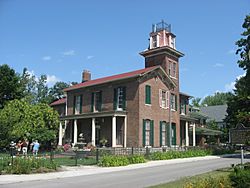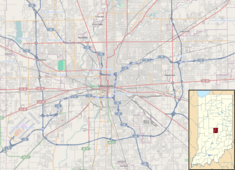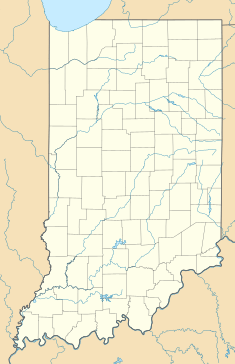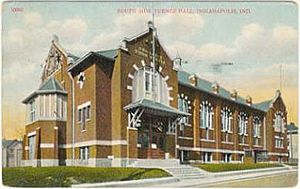Bates–Hendricks facts for kids
The Bates–Hendricks neighborhood is a cool area located just south and east of Downtown Indianapolis in Indiana. It's right next to the Fountain Square business district, which is known for its fun shops and restaurants.
You can easily get to the neighborhood from different directions. East Street brings you in from the north. Terrace Street, off Madison Avenue, leads you in from the west. And Prospect Street connects the neighborhood to Fountain Square.
The Bates–Hendricks House
Quick facts for kids |
|
|
Bates Hendricks House
|
|

Bates–Hendricks House viewed from the southeast
|
|
| Location | 1526 S. New Jersey St. Indianapolis, Indiana, United States |
|---|---|
| Built | 1820s, 1851, 1858 |
| NRHP reference No. | 77000143 |
The neighborhood gets its name from the famous Bates–Hendricks House. You can find it at 1526 S. New Jersey Street. This house is so important that it's listed on the National Register of Historic Places. You can even take a tour if you make an appointment!
The house was built in three main parts over many years. The first part was built around 1830 by Richard Keene. He bought the land from the government in 1821. The second part was finished in 1851 by Hervey Bates. The newest section was completed in 1858.
The older Keene section of the house has a simple, classic Federal design. The larger part, built by Bates, has an Italianate style. It even has a tall, 60-foot tower on one side! This house is one of the oldest buildings still standing in Indianapolis.
Many important people lived in this house. Hervey Bates was the first sheriff of Marion County in 1822. He also helped bring Indiana's first railroad, the Madison and Indianapolis Railroad, to Indianapolis in 1847. Later, he built the fancy Bates House Hotel downtown. Abraham Lincoln even stayed there on his way to become president!
Another famous resident was Thomas A. Hendricks. He served as a U.S. Senator for Indiana. He was also the Governor of Indiana and even the Vice-President!
General John Coburn lived in the house for 30 years. He was a Civil War hero whose troops were the first to enter Atlanta. After the war, he became a U.S. Congressman four times. He also helped lay the cornerstone for the famous Soldiers and Sailors Monument in Indianapolis.
In the early 1900s, the house's tower was home to one of Indiana's first radio transmitters.
Neighborhood History
Madison Avenue, which forms the western edge of the neighborhood, is a very old road. It was the first road built into the area to serve Indianapolis, the new state capital. It was finished in 1824. This road was used to move government tools from the old capital, Corydon, to Indianapolis. It was also a stagecoach road for people to reach steamboats on the Ohio River.
In 1872, James O. Woodruff built the beautiful Victorian neighborhood around the Bates–Hendricks House. He called it Hendricks Place. He later developed another famous neighborhood called Woodruff Place.
In October 1900, a pharmacist named John A. Hook opened his first Hook's Drug Store. It was at the corner of Prospect and East Streets. Hook's grew into a huge chain of over 160 stores. Today, it's part of the CVS Pharmacy chain.
The Sanders-Childers House at 1020 E. Palmer Street is the oldest house in Indianapolis. It's a two-story brick farmhouse built around 1820. The former Abraham Lincoln School #18, built in 1901, is across the street. It stands where a group of Delaware Indians once had a sugar camp.
The South Side Turnverein Hall is at 306 E. Prospect Street. It was built in 1900 by a German-American gymnastics club. The building was designed by the same architects who created the Athenaeum downtown. Even though the club became less popular, the building remained a community center. In 1960, Senator John F. Kennedy even gave a speech there!
The building was later bought and renovated. It reopened in 2018 and is now the headquarters for a company called Point Comfort Underwriters. It was added to the National Register of Historic Places in 2019.
Redevelopment
Since 2010, the Bates–Hendricks neighborhood has seen a lot of renovation. Many houses have been fixed up and sold. Some of these house renovations have even been shown on the TV show Good Bones.
In 2018, the average price for a home in the neighborhood was $189,900. You could find a "fixer-upper" for $41,000 or a fully renovated home for $409,000.
The neighborhood association has a plan to bring more businesses to S. East Street. They want to attract businesses that local residents will enjoy. They are trying to avoid too many chain stores or expensive restaurants.
Karen E. Laine and Mina Starsiak Hawk, from the Good Bones TV show, opened a home furnishings store. It's called Two Chicks District Co. and opened in June 2020 at 1531 S. East Street. The building used to be a silent movie theater!
Green Space
Most of the Bates–Hendricks neighborhood has one- and two-family homes. They have small front yards and bigger backyards. But there are also some public green spaces to enjoy.
Hendricks Park is a small park on the western edge of the neighborhood. It has an abstract sculpture called Play and a small pavilion. Construction on the park finished in 2002.
Ringgold Park is a small, .21-acre park with playground equipment. It was originally built in the early 1900s. The park was moved to its current spot in the 1960s because of the construction of I-65. In 2015, a project helped to make the park even better with new plants and updated equipment.
The Pleasant Run Trail runs through the southeast corner of the neighborhood. It follows a creek and leads to Garfield Park. The parkways along the creek are part of a larger system designed by George Kessler.
Education
There are two elementary schools located within the Bates–Hendricks neighborhood. The James A. Garfield School 31 is an Indianapolis Public Schools elementary school. The Southeast Neighborhood School of Excellence (SENSE) is also for elementary grades.





